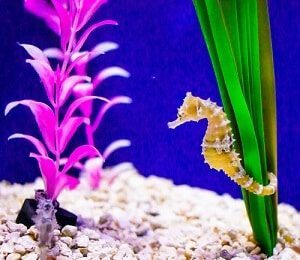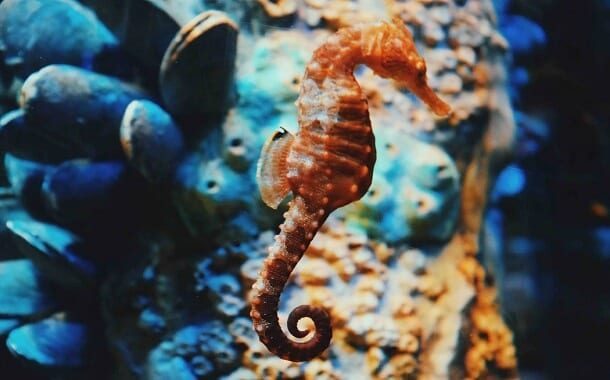How Much Does a Seahorse Cost?
Last Updated on February 24, 2024
Written by CPA Alec Pow | Content Reviewed by ![]() CFA Alexander Popinker
CFA Alexander Popinker
Seahorses are truly unique marine fish that have become popular pets in home aquariums. With their curved bodies, prehensile tails, and horse-like heads, seahorses exhibit some fascinating behaviors not seen in other aquarium fish.
However, caring for these exotic fish can come with considerable costs and responsibilities. This extensive guide will break down the key expenses involved in buying, housing, and maintaining pet seahorses.
Introducing factors like seahorse species, tank setup and maintenance, food, veterinary care, and meeting legal requirements determines the overall investment for successfully keeping seahorses. While not cheap pets, their captivating nature makes seahorses rewarding aquarium inhabitants if provided proper care.
How Much Does a Seahorse Cost?
Over 45 species of seahorses exist, with dwarf seahorses typically being the most affordable at $30-$60 per fish. Popular dwarf species include the Pygmy seahorse and Ponytail seahorse. Larger species like the Yellow seahorse can cost $150-$200 or more for each animal.
Rare colored variants like the White’s Seahorse sell for over $500 apiece due to high demand. The specific seahorse species greatly impacts price. More uncommon seahorses or those harder to breed in captivity also command steeper costs.
Captive-Bred vs. Wild-Caught Seahorses
Captive-bred seahorses are generally pricier at $50-$80 each but are strongly recommended over wild-caught. Removing seahorses from reefs damages already fragile populations in serious decline. Sustainably bred seahorses also adapt better to life in aquariums since they’re born there. Captive breeding allows selecting heartier lineages too.
Still, some unreliable sellers offer illegally imported wild seahorses for $20-$40 due to lack of regulation. Avoid these unethically sourced animals that likely won’t survive or already suffer health issues. The stress of capture also weakens wild seahorses. With many species classified as vulnerable or endangered, only support captive-bred specimens from reputable breeders.
Here are a few examples of websites selling Seahorses:
- Dwarf Sea Horse-Mated Pair: $29.69
- Dwarf Sea Horse 2 Pair: $44.89
- Dwarf Sea Horse 3 Pair (6 seahorses): $59.89
- Dwarf Seahorse Colored Male (Red, Green, Yellow): $19.69
- Calico Dwarf Seahorse: $29.99
- Dwarf Seahorse Female: $9.69
- Dwarf Seahorse Monster 25 Pack: $169.69
- Dwarf Seahorse Super 10 pack: $89.89
- Juvenile Lined Seahorse (Usually Females): $69.69
- Yellow Seahorse: $99.00
- Harlequin Pipefish: $79.90
- Lined Seahorse – Hippocampus erectus: $49.00
- Orange Seahorse: $150.00
- Pipefish: $19.00
- Dwarf Pipefish: $19.00
- Lined Seahorse – Female: $50.00
- Dwarf Seahorse: $9.50 – $75.00
- Lined Seahorse – Male and Female: $120.00
BlueZooAquatics.com sells various seahorses and pipefish are available with prices ranging from:
- Black Seahorse Hippocampus kuda: From $39.99
- Brazillian Orange/Yellow Seahorse Hippocampus reidi: From $199.99
- Lined Seahorse Hippocampus erectus: From $99.99
- Tank Raised Orange/Yellow Seahorse Hippocampus reidi: From $199.99, among others
Setting Up a Seahorse Aquarium
Tank Requirements
A basic barebones 10-20 gallon seahorse tank costs $200-$400 for just the tank, filters, substrate, and lighting. Spending more on a larger tank decreases risks since fluctuations harm seahorses. A fully equipped 40-55 gallon tank with high-quality components easily totals $1000-$2000+.
Tanks should have ample height for vertical seahorse movement. Rimless tanks allow unobstructed swimming but cost extra. Expect to spend hundreds more on live rock arrangements and sand substrates optimized for marine life. Skimping on tank essentials risks poor living conditions.
Filtration, Lighting, and Temperature Control Costs
Robust filtration is crucial for removing waste in seahorse tanks. Plan on spending $50-$200 for efficient protein skimmers, water pumps, and other high-quality filtration systems.
Reef-quality LED lighting with adjustable intensities adds $200-$500 to startup costs. But proper light spectrums promote seahorse health. Reliable tank heaters and chillers for maintaining optimal temperature range -$150-$300+. Don’t overlook equipment investments.
Initial Live Stock and Décor
Seahorses need anchorage points for grasping with their tails. Live corals and macroalgae provide natural holdfasts but add $500+ in expenses for healthy specimens. Safer artificial plants are more budget-friendly for beginners.
Let systems run for 1-2 months to stabilize before adding $50+ per seahorse. Consider adding cleaner shrimp $3-$10 to graze algae or snails $2-$5 to recycle waste. Introduce new tankmates slowly and quarantine all animals first.
You might also like our articles about the cost of pet jellyfish, pet axolotls, or pet octopi.
Ongoing Care and Maintenance Expenses
Water Changes and Parameter Monitoring
Test saltwater aquarium water weekly or twice monthly for $50+ yearly in test kits. Change 10-30% of water biweekly relying on tests. Equipment like automatic water changers for $200+ simplifies maintenance.
Salt mixes and chemical buffers of $50-$150 yearly are needed for ideal seahorse water. Reverse osmosis systems $200-$500 produce pure water for mixing quality seawater too. Don’t forget the costs of replacing filter media either.
Feeding: Types of Food and Costs
Seahorses are voracious eaters requiring multiple feedings daily. Plan on spending $40-$100 monthly on assorted frozen foods like mysid shrimp, krill, spirulina, and enriched frozen brine shrimp.
Live foods like brine shrimp and black worms cost more but provide exercise and are highly nutritious. To vary diet, live copepods, amphipods, and rotifers can be cultured at home. Multi-vitamin supplements $15-$50 monthly are essential too.
Common Health Issues and Veterinary Expenses
Unfortunately, seahorses are prone to many diseases in captivity if water quality or nutrition is improper. Parasitic infections, fungal diseases, and malnutrition require prompt treatment costing $100-$300 per incident.
Catching issues early is critical. Regular aquatic veterinarian visits $75-$200 help diagnose problems through exams and lab tests. Outbreaks spread rapidly in tanks, so have medications ready for common seahorse illnesses. Prevention through immaculate water and a balanced diet reduces disease risks.
Habitat Maintenance
 Seahorse tanks need frequent scrubbing to remove algae competing with corals and invertebrates. Algae scrapers, and magnet cleaners $10-$30 speed up maintenance. Powerheads $50+ improve circulation and water movement too.
Seahorse tanks need frequent scrubbing to remove algae competing with corals and invertebrates. Algae scrapers, and magnet cleaners $10-$30 speed up maintenance. Powerheads $50+ improve circulation and water movement too.
Eventually, corals and live rock must be replaced by $100s-$1000s as they expire after a few years. Swapping out substrate or replacing filtration equipment for $100s extends the system lifespan as well.
Electrical Costs
Operating high-powered aquarium lighting, heating, pumps, and other equipment drives up electrical bills $10-$50+ monthly for seahorse systems. Using energy-efficient LEDs helps lower costs long-term despite higher upfront investment.
Legal and Ethical Considerations
Permits and Regulations
Some areas require exotic pet permits costing $25-$100 annually for seahorse possession. Importing and transporting seahorses across borders can require CITES permits $100-$500 per shipment. Know regulations before buying seahorses to avoid legal penalties.
Conservation and Ethical Sourcing
The exotic aquarium trade threatens wild seahorse populations already endangered by habitat loss. Always research that seahorses are ethically captive-bred rather than wild-caught. Supporting sustainable captive breeding helps fund seahorse conservation efforts.
In the U.S., the Marine Aquarium Council certification denotes seahorses sustainably bred by best practices to take pressure off oceans. Seek out MAC-certified sources when possible. Never purchase wild-caught seahorses even at lower prices.
Additional Equipment and System Upgrades
Automatic Feeders and Monitoring Systems
For seahorses, **automatic fish feeders $50-$150 allow providing multiple meals when away. **Webcams $50+ monitor tanks remotely, sending alerts if issues arise. Automatic water change systems for $200+ simplify maintenance as well.
Backup Systems and Hospital Tanks
Investing in backup heaters and pumps $100+ prevents catastrophes if equipment fails. A smaller **hospital tank $100+ helps isolate sick fish **and speed treatment. For serious hobbyists, consider the costs of setting up redundant systems for safeguarding prized specimens.
Upgrading Tank Sizes
As seahorse collections expand, upgrade costs stack up fast. Moving to a 75-100 gallon $2000+ tank or going for a custom-built 150+ gallon $5000+ aquarium provides ample space. But more water translates to increased lighting, filtration, cleaning, feeding, and maintenance costs long-term.
Seahorse Breeding Program Expenses
Specialized Breeding Tanks
Managing captive breeding requires a dedicated system with features supporting courtship and reproduction. These tailored **30-60 gallon setups $1000+ use special substrates and anchorage for egg attachment after mating rituals.
Successful breeding is complex but allows producing multiple generations. Patience is key, as offspring may not reach sexual maturity for 1-2 years.
Raising Fry
Tiny seahorse fry eat heavily after being released by males and require intensive care. Plan for high live food expenses to feed thousands of hatchlings. Maintain strict water quality and parameters for delicate seahorses under one inch long. Special small nets of $10-$30 help handle large numbers of offspring.
Expect high attrition rates as many fry won’t survive past a few weeks. But a dedicated breeder can produce large numbers of captively bred seahorses over the years.
Final Words
The costs of buying, housing, feeding, and caring for pet seahorses can quickly multiply into the thousands of dollars. But proper investment helps create a healthy marine habitat allowing you to enjoy these charismatic fish.
Research and fully commit to meeting a seahorse’s complex needs before getting one as a pet. The rewards of successfully keeping seahorses make the considerable costs worthwhile for devoted aquarists. With good preparation and focus on optimal care, seahorses can thrive under your dedicated custody.
Frequently Asked Questions
Can I buy a seahorse as a pet?
Yes, certain species of seahorses are available for purchase in the exotic pet trade. Seahorses should only be bought from reputable sources that ethically captive-breed them, never from unreliable sellers offering wild-caught seahorses.
You’ll need an appropriately sized saltwater aquarium fully set up and cycled before introducing seahorses. Expect to spend at minimum $500-$1000 preparing a suitable habitat.
Research regulations in your area, as some places restrict seahorse ownership or require permits adding to costs. Annual pet permits range from $25-$100 depending on location. With proper tanks, care, and legal preparations, seahorses can make fascinating but demanding pets for committed aquarists.
Are seahorses expensive to keep?
Keeping pet seahorses is quite expensive compared to most common aquarium fish. A suitable seahorse tank costs at minimum several hundred dollars for even a small 10-20 gallon setup with basic equipment.
But ideally, invest $1,000+ on a larger 40+ gallon tank with high-quality components to create a stable habitat. The tropical marine environment seahorses require is costly to recreate and maintain. Investing in optimal water conditions reduces disease risks though. You’ll also need high-powered lighting, efficient filtration, and temperature control amounting to $500+ in equipment.
Feeding live and frozen foods specially tailored to seahorses gets pricey at $40-$100 monthly. Treating any health issues requires medications costing $100+ per incident. Overall expect to spend $2000+ initially and $100-$300 monthly for properly caring for pet seahorses. But the costs are worthwhile for devoted aquarists captivated by their unique nature.
Is it OK to touch seahorses?
It’s best to avoid touching seahorses unless absolutely necessary. Seahorses have delicate bodies covered in bony plates that can be easily damaged by handling. Their fins tear easily as well. Anything other than very gentle handling for health examinations or tank transfers risks injuring seahorses.
It’s also important to avoid touching their tails, which they use to cling to objects. Seahorses rely on their grip and can lose hold of things if their tails are compromised. Limit handling to what’s essential for their wellbeing.
With patience, you can train some seahorses to gently hold onto your hand when needed. But minimize contact to avoid stressing or harming them. Gentle observation is key to safely enjoying pet seahorses.
Let them acclimate before interacting and approach slowly to allow them to voluntarily attach to your hand. While seahorses can bond with their caretakers, respect their sensitivity.


Leave a Reply
Want to join the discussion?Feel free to contribute!